[Bushin Inari Shrine] The secret story of Ryoma Sakamoto’s romantic love affair with Kyoto is here!
Bushin Inari Shrine is located right in the middle of the Kyoto Sanjokai shopping street, east-west.
There are many places in Kyoto associated with Ryoma Sakamoto,
If you know about this place, you must be a big Sakamoto Ryoma fan.
Famous places in Kyoto where you can feel the presence of Sakamoto Ryoma are,
Teradaya in Fushimi, Reizan Gokoku-jinja Shrine in Higashiyama, the former site of Omiya in Kawaramachi,
Susa, the site of the Tosa Clan, and Misaki Shrine in Kawaramachi,
And perhaps the ‘Torishin’, where he was sent to buy chicken on his last day.
If you want to follow in Ryoma Sakamoto’s footsteps in Kyoto, or if you are a big fan of Ryoma Sakamoto, this is the place for you.
You can’t miss the Bushin Inari Shrine if you want to follow in Ryoma Sakamoto’s footsteps in Kyoto.

I know I sound like a big shot, but the fact is that we also came to know about this Bushin Inari Shrine by chance.
I found it by chance when I was wandering around the Kyoto Sanjo-kai shopping street.
It is about a 20-minute walk from JR Nijo Station and Nijojo-mae Station on the Tozai Line.
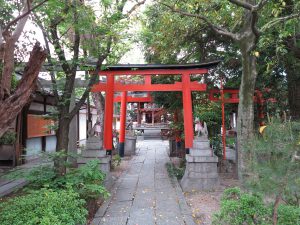
Because all of a sudden my child said, ‘I need to go to the toilet! and went into the precincts of this shrine lol.
Thankfully, the people at the shrine lent us the toilet. How kind.
Meanwhile, I was reading about the history of the Bushin Inari Shrine and other things, and I was like, ‘What? Ryoma Sakamoto was here!’ I was like.
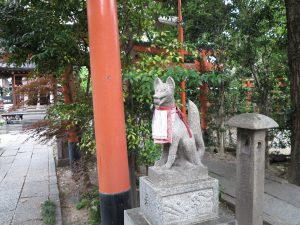
The grounds of the temple are very clean. You can see that it is well cared for by the local people.

There are summer festivals and other events, and there is quite a bit of interaction with the town.
The size of the shrine is good, and it’s a shrine that I feel attached to.
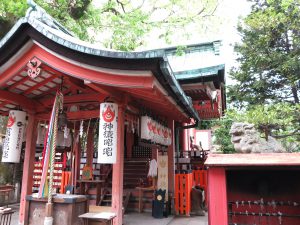
It was built in 859 in the early Heian period.
And this shrine, to the surprise of many, is also associated with ‘Issunboushi’.
Issunboshi comes to Kyoto to become a samurai.
He lives and serves at the residence of the ‘Minister-dono of Sanjo in Kyoto’.
Sanjo no Minister-dono means Minister Nishi Sanjo, who, to his surprise, is the founder of this shrine.
The Minister’s residence was located here.
When you are in Kyoto, you often hear stories like this.
Because the stories are about places and people that really existed, it makes you wonder if Issunboushi really existed too. So, was Issunboushi really there too?
Moreover, I believe that Issunboushi was eaten by demons on his way to Kiyomizu-dera Temple as an attendant of the princess,
He was eaten by an ogre on his way to Kiyomizu-dera Temple, and was exterminated by a prickly needle sword in his stomach.
The story is a little bit of reality, isn’t it? It’s like a novel by Manjome Manabu.
It’s like a novel by Manjome Manabu.
So, this shrine,
When Issunboshi exterminated the demons, they dropped the Uchide-no-Kozuchi (a small mallet), which is believed to bring good luck in terms of money,
It is also said to be good for luck in money, as the ogre dropped the hammer when Issunboushi killed the ogre, or that Issunboushi was married to a princess,
Well, they’re good at business. To be honest, the whole of Kyoto is like this.
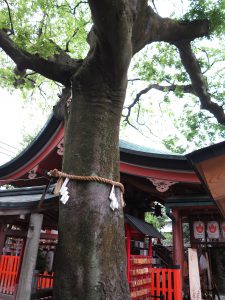
Now, let’s talk about Sakamoto Ryoma and the Bushin Inari Shrine.
Below is a rough translation of what was written on the signboard of the shrine.
There was a prison called Rokkaku Jailhouse to the south of the shrine.
At the end of the Edo period, many loyalist warriors were imprisoned there.
Sakamoto Ryoma’s wife Oryo’s father was among them.
Ryoma and Oryo visited him several times, but as Ryoma himself was being chased, they were unable to meet him and watched him from the top of this large tree.
After that, Ryoma went into hiding and was unable to see Oryo.
Oryo was worried about Ryoma, but suddenly remembered the Bushin Inari Shrine and went there,
On this enoki tree was written ‘Ryu’ in Ryoma’s handwriting.
Oryo got the message that he was still alive and that he was in Kyoto,
He visited their mutual acquaintances and they were able to meet again.
Enoki is also known as the ‘tree of fate’, and the Miyahime Shrine, the final shrine dedicated to the goddess Benzaiten, who dwells in the sacred enoki tree, is the god of matchmaking.
It is said that Oryo and Ryoma are two people who received such a blessing of marriage.
Sakamoto Ryoma, indeed. Love is dramatic too!
Or rather, he is a popular person when his love life is also featured.

So, it is a quick monetisation lol.
Nevertheless, the overall impression is modest and positive.

Ryoma says! Ryoma omikuji!
Apparently, the omikuji is written in Tosa dialect.
Well, I guess it’s just modest.
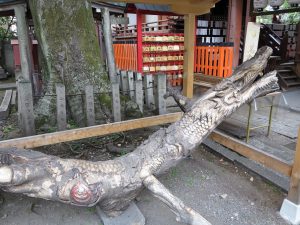
Chainsaw artist Keiji Kidokoro created dragon art from the dead branches of a sacred tree.
But, according to Mr Kidokoro, the dragon already existed there. Mysterious.
and the Bushin Inari Shrine where you can feel Ryoma’s unusual love episodes.
This is a Kyoto hole-in-the-wall spot that Ryoma fans should not miss.
Mushin Inari Shrine
38, Imashin Ienkaishimachi, Nakagyo-ku, Kyoto-shi, Kyoto
tel : 075-841-3023 / fax : 075-496-9955





